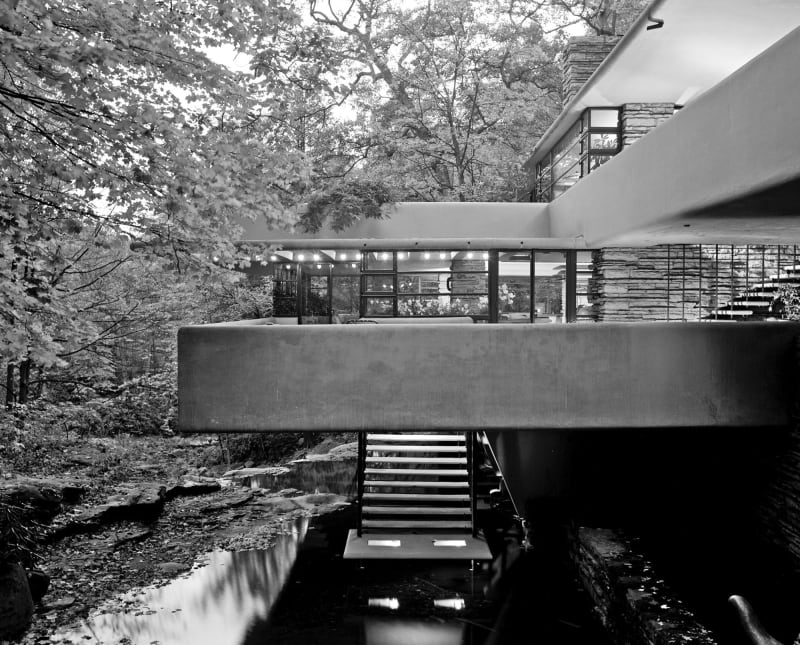The name Ezra Stoller may ring familiar only to architecture professionals, but the imagery archive behind the name enjoys a wider familiarity that many viewers will immediately recognize his photographs as the first and by-default impression they have had on the architecture photographed. Within Stoller's iconic portfolio, there are signature photographs of Fallingwater, The Guggenheim Museum, and the TWA Terminal. Some of Stoller's photographs have cast an influence so impactful that later architectural photographs also refer to his perspective and re-interpret his seminal meta-images.
Stoller's career was roughly contemporaneous with architecture modernism. From late 30s to 80s he has worked with Frank Lloyd Wright, Paul Rudolph, Marcel Breuer, I.M. Pei, Gordon Bunshaft, Eero Saarinen, Richard Meier and Mies van der Rohe among others. With these architects Stoller has collaborated and composed a neutral, canonical dictionary of photographs with an impersonal classicism and an enduring artistic silence. And several decades later, with awe and in reflection, when we again look at Stoller's photographs, there also rises a question that only reveals itself with time: what gives Stoller's work its timelessness?
Architectural photography, the compound word which functions as an ambiguous reference to the Stoller's genre speaks of a multi-layered complexity innate to the particular strand of imagery-making. The genre seems to evoke a trinity of look in every critical gaze at an architectural photo: an eye to the photograph, a mind's eye to the architecture, and a constant attention to the on-going interplay between the image and the building. As like each classic architecture photographer, Stoller has his own formation of the trinity of look, and it is through this he spells out his own interpretation on architecture - the beautifully human-made structure, on time, and on our dwelling in architecture and in time.
When asked to explain Stoller's enduring influence, Pierluigi Serraino, author of a monograph on Ezra Stoller, made a radical argument: "His [Stoller's] love of architecture came from architecture, not photography. When I say he was an architect with a camera, I mean that in the most genuine way." Indeed, unlike many photographers of his age, Stoller has presented more caution and reserve when faced with new experimental techniques and cinematic expressions. In Stoller's work, a viewer can so rarely spot an accidental happening like a vehicle swooshing, a pedestrian passing by. The scene is as a silent deep water, deprived of all randomness - it was as so when Stoller first photographed, and it remains as so at the third, the thousandth glance.
"An architect with a camera" describes not Stoller's estrangement with the photographic technique, but the slow, thoughtful practice of his old-school method that almost makes him estranged from the profession. To capture the architecture in a scene deprived of all randomness is the true scarcity; it is like capturing a highly-occupied stage without play or pops, and unsurprisingly, it demands patience, time and a photographer's hard labor. Before every official shooting, Stoller would take a long walk around the architecture to silent read and inhale his photographic subject. During the walk, he would remain wordless, conduct conversations that only pertain to the necessary information. It is as if he has been tacitly translating, from a language of space, structure and material, to a language of time and light and color.
A laboriously tamed language of photography makes way for an accurate presentation of architectural content. Stoller's photographic language is finely organized, gracefully simple, and again classic. It reminds people of the English spoken by bachelors from old private school: its grammar well-maintained, its tone harmoniously tuned. Within the genre of black-and-white film, Stoller renounces the theatricality of high contrast and contains his greyscale always inside a safe spectrum. One of the effects made possible by this method is that Stoller is capable of portraying simultaneously the building structures and their shadows without a sharp separation nor claiming a dominance either for the light or shadow. The effect is as if the architecture is exposed in a day not excitingly bright, not depressingly gloomy, but a day of neutral weather, of no weather, in a day as you imagine every day and all days will be.

